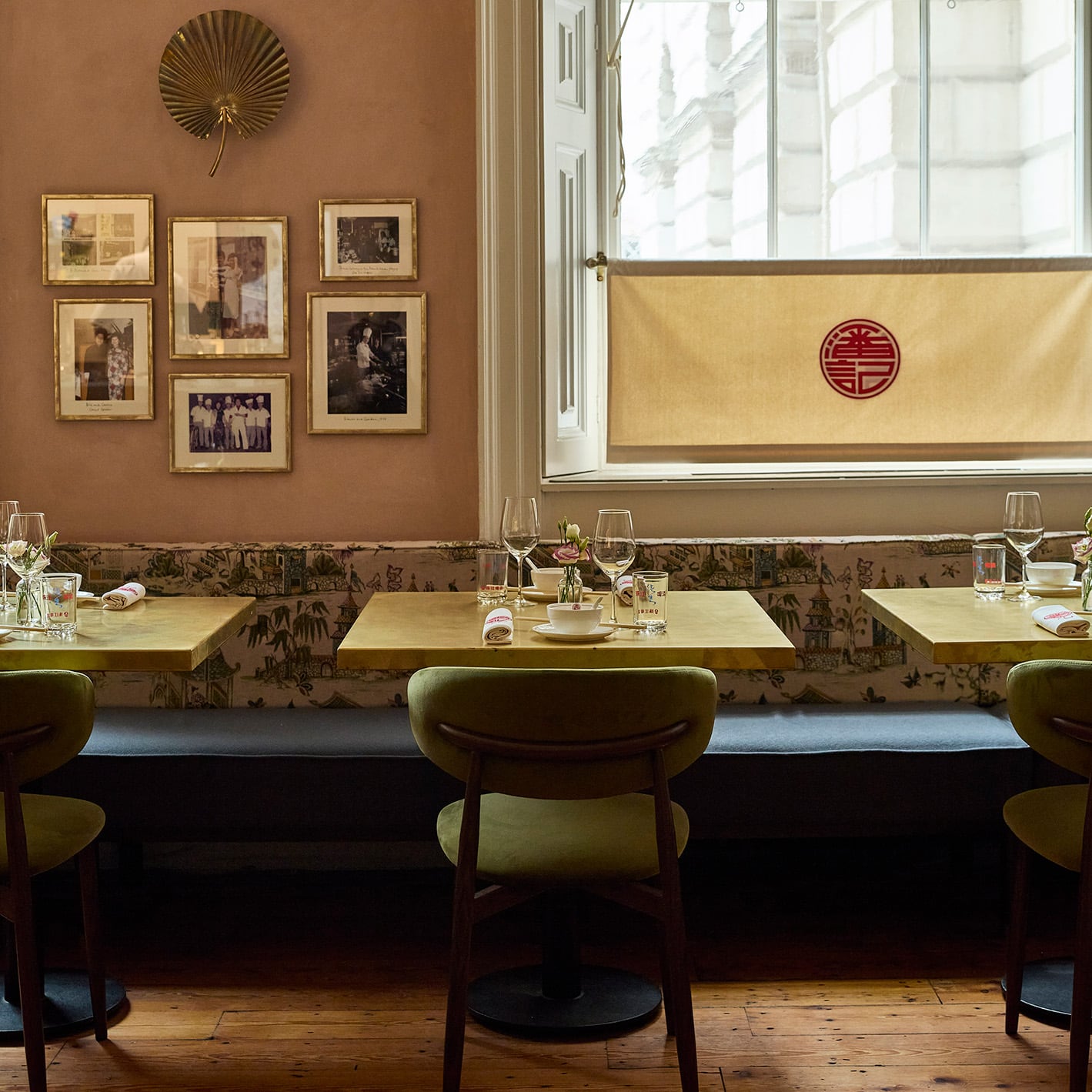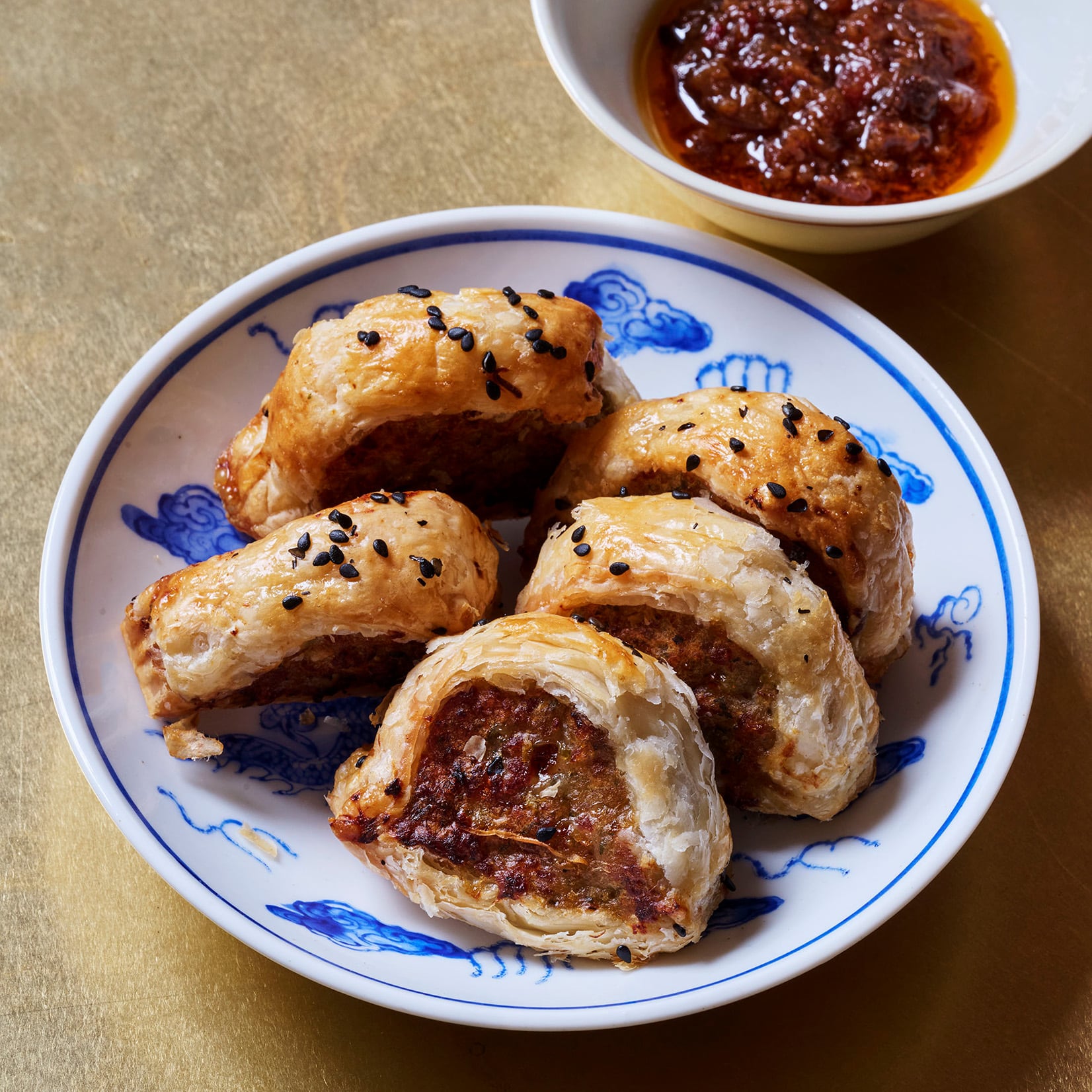Poon’s wasn’t the first restaurant I remember going to. That honour goes to Pizza Express’s Coptic Street site near the British Museum with its telephone box-red metal seating and loud Italian waiters with big arms who could carry half a dozen pizzas to the table in one go. But it was the first that I demanded to go back to again and again.
My strongest memory is the smell of the place: sweet wind-dried meats and a hint of bleach - the restaurant was always scrupulously clean. I also remember the worn but pretty china - dainty rice bowls and soup spoons - with their red Poon’s logo stamp, sat alongside melamine chopsticks with faded Chinese characters etched into their glossy surface.
We only ordered a handful of things from the expansive Cantonese menu: wonton soup; a selection of barbecued meats that included roast belly pork with that neat layer of perfectly crisped fat that only Chinese restaurants seem able to do; char siu pork and - I think - duck; plain steamed rice; a stir-fried vegetable dish that was far more than the sum of its parts; and chunks of pork belly and eel stewed in a battered metal pot.
Nobody can recall how my father alighted on the latter dish as his go-to, but I do remember the staff nodding approvingly when I happily tucked into it. I must have been about 10 years old. The service was efficient and at times stern but, I would later come to appreciate, considerably warmer than most Chinatown restaurants in the 1990s.

Creating a Cantonese restaurant empire
Another thing I wasn’t aware of at the time was that there was more than one Poon’s. Bill, a seventh-generation master chef, and Cecilia Poon started out on Lisle Street in 1973 before moving the main operation to more salubrious digs on nearby Leicester Street. This is the one we always went to, but the pair, along with their extended family, launched a string of Poon’s restaurants across the capital, including a flagship site in Chinatown that briefly held a Michelin star. At the group’s 1980s peak there were a total of seven restaurants including - oddly - a Switzerland outpost.
Bill and Cecilia retired in 2006, having done more to elevate the profile of Chinese food in London than anyone. Though Poon’s set the stage for a new generation of chefs that wanted to offer a more progressive take on Chinese food, its departure also left a gaping hole, with its many fans – not least myself – bereft at not being able to get their Poon’s fix.
But after a two-decade hiatus, Poon’s has returned in full-service form with a beautiful restaurant within Somerset House’s New Wing. Bill and Cecilia’s daughter Amy has been working to bring back the Poon’s brand - which actually never fully disappeared thanks to the family’s popular range of wind-dried meats adorned with its patriarch’s wonderfully weathered and severe face - for the past decade or so.
This has included an expanded range of Poon’s-branded retail products, including sauces, wontons and merchandise, which have been so successful that the business now has a production and retail space in south London’s food production and distribution hub Spa Terminus, as well as Wontoneria pop-ups (no prizes for guessing what they sold) at Stevie Parle’s pandemic-born JOY restaurant in Ladbroke Grove and later at Fitzrovia’s Carousel.

A difficult rebirth
Bringing back Poon’s as a full-service restaurant has been a tougher nut to crack. In 2018, Amy launched a three-month Poon’s pop-up underneath a block of flats in Clerkenwell. Though oversubscribed, the project – launched in the hope of attracting investment for a rollout of Poon’s casual dining sites – taught her that nothing can ever taste as good as nostalgia.
“We had one customer that came in and was obviously disappointed and disgruntled because it wasn’t his memory of Poon’s. That experience taught me not to mess with people’s rose-tinted memories,” says Amy, who had a varied career prior to her return to the family business, including advertising, events, selling Chinese contemporary art and running a champagne bar in Singapore’s red-light district.
“There’s an awful lot of love for the name. That’s touching, humbling and also very scary”
Even though it sounds like she wasn’t that proud of it (“the key learning was that I knew nothing”) the project did attract investment. However, Amy’s backers pulled out at the eleventh hour due to the pandemic, which saw her switch her focus to the retail side of the business.
“If I’m really honest with myself, I think there was a big part of me back then that didn’t want a Poon’s restaurant to work,” Amy says of her first attempt to recreate her parents’ restaurant. “I just wanted to say that I’d tried. Legacy is such a heavy word, but I have been gifted this wonderful thing that I think I can do something with. But I am not my father.”
Poon’s at Somerset House is not intended to be something that will scale and isn’t intended to be a facsimile of the original Poon’s restaurant either. Far from it, in fact. Officially launched yesterday (5 November), the restaurant is inspired by the dishes its owner ate at home rather than those her father cooked in the restaurant.
“My mother did nearly all the cooking at home. My father cooked occasionally but it was often a drama because he was trying to cook restaurant food. My mother’s technique was much simpler,” says Amy, who believes that this lighter, less technical side of Chinese cooking is not widely understood by those from a non-Chinese background.
“There’s a lot more to Chinese food than Peking duck and dim sum. Your average Chinese housewife would never make those dishes. Some time ago, a friend of mine came round and I did a simple meal of steamed fish and stir-fried vegetables. She didn’t recognise it as Chinese food because it was so light, simple and healthy. That really stuck with me. I’m not sure anyone has really shown this side of Chinese food in London.”

A new kind of menu
As a result, Amy’s menu is very different from what most would expect to order in a Chinese restaurant. For a start, it’s just a single side of A4 with a layout that brings to mind a French brasserie - it even uses terminology like plat du midi and table d’hôte - rather than the multi-page affair proffered at the original Poon’s and practically every other Chinese restaurant in the UK.
Split into sections including siu sik (small eats), wontons, starters, larger dishes, claypot rice dishes and noodles, the menu offers only around 30 dishes in total. Smaller dishes include crudités with whipped furu (fermented tofu); steamed hand-dived scallop with garlic and glass noodles; and mini sausage rolls made with Poon’s wind-dried sausage.
“My mum told me that there are some dishes that one must put on the menu to pay the rent, the staff and the electricity bill, and that prawn toast is one of them. It was one of the dishes that apparently paid for my schooling”
More substantial options include whole seabass steamed with Poon’s First Extract Soy Sauce, spring onion and ginger; and poached poussin served with ginger and spring onion relish and Poon’s Extraordinary Chilli Oil.
There are only a handful of signatures from the original Poon’s restaurants, including claypot rice with wind-dried meats; the roast duck salad created for Poon’s Covent Garden (now a Chinese restaurant staple, having been borrowed by many others, not least Hakkasan); and the original Lisle Street site’s famed zha jiang (cooked sauce) noodles.

The hill Amy didn’t die on
Amy is also playing with the Chinese tradition of giving dishes poetic names – for example, Buddha jumps over the wall and ants climbing a tree – with a dish entitled The hill that Amy didn’t die on.
Amy doesn’t like sesame prawn toast on account of its ubiquity on Chinese and non-Chinese menus alike and wasn’t planning to have it on her menu until her mum had a word. “She sat me down and told me that there are some dishes that one must put on the menu to pay the rent, the staff and the electricity bill, and that prawn toast is one of them. In fact, it was one of the dishes, along with the zha jiang noodles, that apparently paid for my schooling.”
But Amy was determined to do something different and, after a chat with her dad, created a version inspired by the original, which doesn’t involve toast. “It’s a proper heritage recipe that I don’t think you even see in Hong Kong these days,” she explains. “Instead of toast, we marinate strips of pork back fat (lardo) in rose liquor before topping with the prawn and sesame mix.”
The kitchen at Poon’s Somerset House is closer to a western kitchen than a traditional Chinese restaurant kitchen. There aren’t even any heavy-duty wok burners – partly because open-flame cooking isn’t allowed in the Grade I-listed building, but also because the menu doesn’t require it.
“Steaming is the antithesis of the tattooed male chef with a beard cooking over open flame. It’s very subtle and feminine”
“You don’t really need any specialist cooking kit to produce home-style Chinese food,” Amy says. “Very few Chinese people have proper wok burners in their homes. I make delicious stir-fries at home, but I do it on an induction hob.”
Many dishes will be steamed, a technique Amy believes to be underappreciated by Western cooks. “It’s the antithesis of the tattooed male chef with a beard cooking over open flame. It’s very subtle and feminine. There’s a real purity to it and it’s respectful of the product. It’s an especially good technique for seafood, which we have a lot of here.”

Going it alone
Amy’s father was involved in the Clerkenwell pop-up - Amy recalls him chastising young cooks for their lack of knife skills and “generally terrifying everybody” - but isn’t really involved this time round.
“He’s not been very well recently, sadly,” she says of her father. “He has been a sounding board for my ideas. He is a little bemused by how uncheffy it all is. He broke a lot of rules back in the day, but he now has quite a traditional attitude to how Chinese restaurants should be run. But he has been very supportive.”
Her mother, on the other hand, thinks her daughter has gone mad. “She questions why I’m doing it. Even though it was my father who attracted the star and was the face of the business, none of it would have happened without her. She was behind the scenes managing everything on top of running the household. Frankly he couldn’t find his socks without her.”
Cecilia is concerned that her daughter has too much on her plate with Poon’s rapidly growing retail business and now a complex, high-profile London restaurant.
“Unfortunately, she’s absolutely right. It’s probably all too much and she understands better than anyone what this business takes from people. She worries and asks me if I’m getting enough sleep and doing other important things like eating and speaking to my children. But we need this little showcase. There’s an awful lot of love for the name. That’s touching, humbling and also very scary.”


